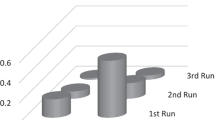Summary
First descendants' founding ability was tested inP. dominulus colonies by experimentally removing the original nests and queens 21–24 days after the first emergence. Foundation tests were carried out after three different periods had elapsed after the removal and the results were analyzed with regards to the effects of participation in social tasks, duration of stay within the colony and seasonal factors. 1.Immediately after the removal, the foundations that occurred were performed almost entirely by workers, regardless of the duration of their stay within the colony. The number of foundations depended on the season in which the females had emerged. 2.Two months and four months after the removal, foundations were made by only a small number of females (workers and non-workers). These females, which were therefore able to found a nest the year they were born, were mostly among the very first-born individuals in the colonies. 3.The following year after hibernation: females (workers and non-workers) which had stayed for only a short time within the colony (1–15 days) had the highest survival rates. The foundation rates among the surviving females depended only on seasonal factors, since the foundation rates were higher among the non-workers which had emerged later in the season. The results throw some light on the first descendants' nest-founding potential in colonies developing under natural conditions, where many workers in fact stay for only a short time at the nest.
Similar content being viewed by others
References
Bohm, M. K., 1972. Effects of environment and juvenile hormone on ovaries of the wasp,Polistes metricus.J. Insect Physiol. 18:1875–1883.
Chandrashekara, K. and R. Gadagkar, 1992. Queen succession in the primitively eusocial tropical waspRopalidia marginata (Lep.) (Hymenoptera: Vespidae).J. Insect Behav. 5:193–209.
Deleurance, E. P., 1952. Le Polymorphisme social et son déterminisme chez les guêpes.Coll. Int. CNRS 34:141–155.
Gadagkar, R., 1987. Social structure and the determinants of queen status in the primitively eusocial waspRopalidia cyathiformis. In:Chemistry and Biology of Social Insects (J. Eder and H. Rembold, Eds.), Verlag J. Peperny, Munich, pp. 377–378.
Gervet, J., M. Pratte, S. Semenoff and D. Gabouriaut, 1986. Pattern of offspring production in colonies of paper wasps (Polistes gallicus L.). II. Demographic data. Hypotheses concerning fitness implications.Ins. Soc. 33:375–387.
Hughes, C. R., M. O. Beck and J. E. Strassmann, 1987. Queen succession in the social waspPolistes annularis.Ethology 76:124–132.
Hughes, C. R. and J. E. Strassmann, 1988. Age is more important than size in determining dominance among workers in the primitively eusocial wasp,Polistes instabilis.Behaviour 107:1–14.
Itô, Y., 1986. Social behaviour ofRopalidia fasciata (Hymenoptera: Vespidae) females on satellite nests and on a nest with multiple combs.J. Ethol 4:73–80.
Itô, Y. and Sk. Yamane, 1985. Early male production in a subtropical paper waspRopalidia fasciata (Hymenoptera: Vespidae).Ins. Soc. 32:403–410.
Jeanne, R. L., 1972. Social biology of the neotropical wasp,Mischocyttarus drewseni.Bull. Mus. Comp. Zool. Harvard Univ. 144:63–150.
Jeanne, R. L., 1980. Evolution of social behavior in the Vespidae.Ann. Rev. Entomol. 25:371–396.
Khalifa, A., 1953. Biological observations onPolistes gallicus L. andPolistes foederatus Kohl, with special reference to stylopization.Bull. Soc. Found. 1 Entomol. 37:371–404.
Litte, M., 1979.Mischocyttarus flavitarsis in Arizona: Social and nesting biology of a polistine wasp.Z. Tierpsychol. 50:282–312.
Lorenzi, M. C. and S. Turillazzi, 1986. Behavioural and ecological adaptations to the high mountain environment ofPolistes biglumis bimaculatus.Ecol. Entomol. 11:199–204.
Makino, S., 1989. Usurpation and nest rebuilding inPolistes riparius: two ways to reproduce after the loss of the original nest (Hymenoptera: Vespidae).Ins. Soc. 36:116–128.
Mead, F. M. Pratte and D. Gabouriaut, 1990. Influence d'une différence dans les conditions de température et de durée du jour sur le déroulement de la vie de la société chezPolistes dominulus Christ (Hymenoptera: Vespidae) élevé au laboratoire.Ins. Soc. 37:236–250.
Mead, F. and D. Gabouriaut, 1993. Post-eclosion sensitivity to social context inPolistes dominulus Christ females (Hymenoptera, Vespidae).Ins. Soc. 40:11–20.
Pardi, L., 1946. Ricerchi sui Polistini. 7. La “dominazione” e il ciclo ovarico annuale inPolistes gallicus (L.).Boll. Ist. dei Entomol. Univ. Studi Bologna 75:25–84.
Pardi, L., 1948a. Dominance order inPolistes wasps.Physiol. Zool. 21:1–13.
Pardi, L., 1948b. Ricerche sui Polistini. 11. Sulla durata della permanenza delle femmine nel nido e suh' accrescimento della societa inPolistes gallicus (L.).Atti della Societa Toscana di Scienze Naturali 55:1–15.
Pratte, M., J. Gervet and S. Semenoff T. C., 1984. L'évolution de la production de descendance dans le guêpier de Poliste (Polistes gallicus L.).Ins. Soc. 31:34–50.
Solis, C. R. and J. E. Strassmann, 1990. Presence of brood affects caste differentiation in the social wasp,Polistes exclamans Viereck (Hymenoptera: Vespidae).Functional Ecol. 4:531–541.
Strassmann, J. E., 1981. Evolutionary implications of early male and satellite nest production inPolistes exclamans colony cycles.Behav. Ecol. Sociobiol. 8:55–64.
Strassmann, J. E. and D. C. Meyer, 1983. Gerontocracy in the social wasp,Polistes exclamans.Anim. Behav. 31:431–438.
West-Eberhard, M. J., 1969. The social biology of polistine wasps.Misc. Publ. Mus. Zool. Univ. Mich. 140:1–101.
West-Eberhard, M. J., 1978. Temporary queens inMetapolybia wasps: non-reproductive helpers without altruism.Science 200:441–443.
Wheeler, D. E., 1986. Developmental and physiological determinants of caste in social Hymenoptera: evolutionary implications.Am. Nat. 128:13–34.
Author information
Authors and Affiliations
Rights and permissions
About this article
Cite this article
Mead, F., Gabouriaut, D. & Habersetzer, C. Nest-founding behavior induced in the first descendants ofPolistes dominulus Christ (Hymenoptera: Vespidae) colonies. Ins. Soc 42, 385–396 (1995). https://doi.org/10.1007/BF01242167
Received:
Revised:
Accepted:
Issue Date:
DOI: https://doi.org/10.1007/BF01242167




